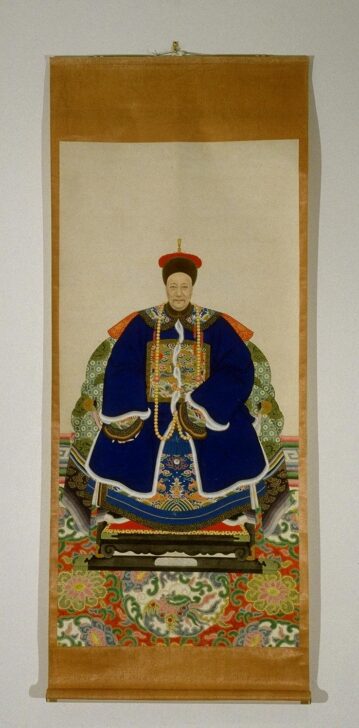Ancestral Portrait, Male
Chinese

Description
Ancestral portrait, male official
China
Qing dynasty (1644–1912)
1875–1912
Hanging scroll, ink, color, and gold on paper
Gift of Richard Edwards in honor of Ellen Johnston Laing, 2002/1.218.1
This painting presents a portrait of late-Qing social position,
role, and rank. It depicts an official in his formal court
attire (zhao fu), which was worn with a piling (wide collar or
capelet) over the shoulders. The outfit also included a hat
with decorations denoting rank and a looped court necklace.
Though these necklaces always had the same number of
beads (108), beads with larger diameters resulted in a longer
chain, such as the one worn by the official here. This style
was common in the late Qing period. The square civil
official badges worn on the front and back of the court robes,
examples of which are displayed in a nearby case, identified
the wearer’s rank. The mandarin duck denotes that this man
is a seventh-rank civil official.
Traditionally Qing-dynasty ancestral portrait paintings
emphasized verisimilitude in the depiction of faces because
they were treated as objects of familial worship rather than
art.
Subject Matter:
Formal male (and female) court dress was worn with a piling (wide collar or capelet) over the shoulders. The costume also included a hat with decorations denoting rank and a looped court necklace. Though these necklaces always had the same number of beads (108), those with larger diameters resulted in a longer chain, such as the one worn by the official in this painting. This style was common in the late Qing period. The figure’s blue winter surcoat has an insignia badge with a Mandarin duck surrounded by clouds; this suggests he is a seventh-rank civil official (there were nine ranks in the civil official or wenguan hierarchy in the Qing court). Traditionally, as here, Ming (1368–1644) and Qing dynasty ancestral portrait paintings emphasized verisimilitude in the depiction of faces because they were treated as objects of worship rather than art. The receding ground plane, use of oblique lines in the top section of the tapestry, and three-dimensional presence of the body in this painting, however, suggest there is also a Western influence.
Physical Description:
This late Qing portrait depicts an official in his formal court costume.
Usage Rights:
If you are interested in using an image for a publication, please visit https://umma.umich.edu/request-image/ for more information and to fill out the online Image Rights and Reproductions Request Form.